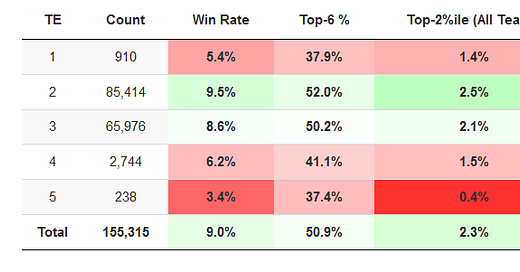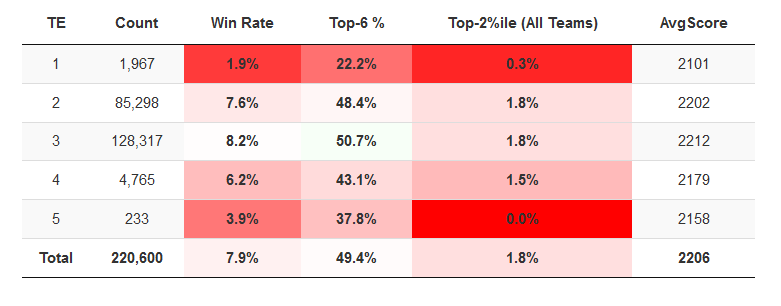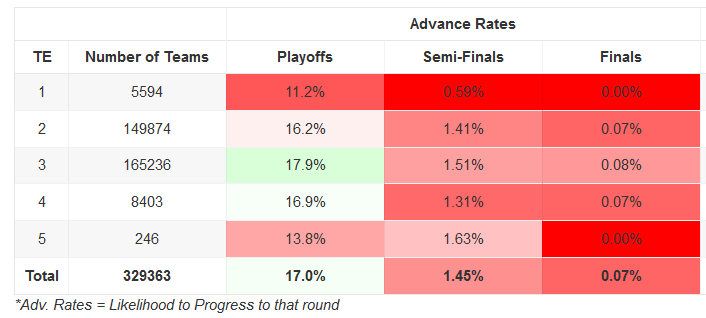Tight End Strategy in Best Ball Mania IV
Can't we just punt with late-round tight end? Not so fast, my friend...
Introduction and Key Takeaways
Over the last two years, there’s seemingly been a rise in the number of analysts calling for a Late-Round Tight End strategy. Just this morning, I had Twitter discussion with Sam Sherman and Justin Herzig, each of whom I consider sharp drafters, on tight end strategy, where they both seemed to express a preference for Late-Round Tight End strategy. This surprised me, as I’ve viewed the strategy of tight ends in best ball as a mostly settled question since Shawn Siegele’s Best Ball Workshop series (lessons 2 and 5) going back a few years on Rotoviz. Below, I analyze the pros/cons of the Elite Tight End and Late-Round Tight End strategies.
Key Takeaways (for those just interested in the results):
Elite TE (TE1 before round 7, 2 total) likely offers average win rates with significantly higher playoff upside.
Late-Round Tight End (TE1 after round 6, 3 total) likely offers above average win rates, but it comes at the cost of playoff upside.
With that in mind, if you want to skip the game theory, specific player takes are at the bottom of the article.
The Debate
Going back to Shawn’s Best Ball Workshop analysis, it essentially said that, Elite Tight End was an edge because of the combination of spike weeks at the position and the ability to devote one less roster spot to the position. If you missed on an Elite Tight End build, drafting 3 tight ends late was a solid back-up plan. From 2015-2021, this analysis was backed by the data we had for Fanball, as we see from the images below.
TE1 before round 7 (Elite Tight End), Fanball 2015-2021
TE1 after round 6 (Late-Round Tight End), Fanball 2015-2021
Fanball vs Underdog
Sam Sherman, and others, have made the point that Underdog is only 0.5ppr, while Fanball is full-ppr. This is undoubtedly a slight boon to the Elite Tight End strategy. However, Fanball is also a 20-round format, compared to Underdog’s 18. It seems logical that given the extra two rounds, tacking on a 3rd tight end late, when you can still draft fringe starters compared to backups at RB/WR, that a strategy of three Late-Round Tight End would do better, but that is not the case. Ultimately, I think the Fanball data is at least directionally correct, and given the disparity in win rate, top 50% rate, and top 2% rate, suggests that Elite Tight End should be our foremost strategy. Fortunately, we are starting to build out our Underdog data set as well.
Recent Results on Underdog
As we see from the Underdog Roster Construction Explorer, Elite Tight End has only been average in advance over the last two season. This follows after it generated an above average advance rate in 2020. However, the elite tight ends have still provide meaningful upside in the playoff weeks, which we should expect.
TE1 by round 7, Underdog 2021-2022
By comparison, 3 late tight ends generated a better advance rate, but it underperformed in the playoff weeks.
TE1 after round 6, Underdog 2021-2022
This held true regardless of how late you took your first tight end, suggesting that the late tight ends cannot match the weekly upside of the elite tight ends, which is what my research has shown.
Ultimately, in the playoff weeks, it seems that drafting three late tight ends is essentially a bet against any of the elite tight ends from going off, which is something that BBM1 champ Justin Herzig and I discussed last year. My research (albeit only a two-year sample), suggests that on any given week, there’s roughly a 50% chance one of the elite tight ends scores 20+ points, while a combination of three random late-round tight ends offer an ~7% chance of scoring 20 points. While a 50/50 proposition may sound enticing for the Late-Round Tight End strategy, the gauntlet of playoff best ball makes this even harder for the late tight ends.
Best Ball Mania IV
In Best Ball Mania IV, we need to finish 1/16 to advance in week 15, 1/16 to advance in week 16, and the money is concentrated to the top few places in the 441-person final. Instead of one 50/50 bet, we now need to run that bet three consecutive times, meaning that over the course of those three weeks, there is a roughly 85-90% chance of one of the elite tight ends going off. Furthermore, we have seen this exact scenario play out the last two seasons in Best Ball Mania.
In 2022, George Kittle was a lower-than-average advance rate player. But after two consecutive boom weeks, he offered the highest semi-final and finals advance rate of any tight end, and the highest finals advance rate of any regularly drafted player. In the finals, he only scored 10 points, but was still on the tournament winning team. In short, George Kittle, despite having a mediocre overall season, was one of the key “guys you had to have.”
Kittle’s 2022 Playoff Domination
In 2021, a similar scenario played out. With Travis Kelce serving as the low-advance-rate but key playoff contributor, and Mark Andrews generating the second-highest semi-final advance rate and highest finals advance rate of any player. Both were key pieces to playoff success.
Kelce/Andrews Critical to 2021 Playoff Success
Ultimately, in both 2021 and 2022, elite tight ends were key playoff pieces, despite mixed regular season results.
Final Strategy Thoughts
If you are playing to win the playoff aspect of Best Ball Mania IV, then an Elite Tight End strategy should likely be your first choice, as it offers average advance rates with weekly ceiling in the playoffs.
If that fails, then a three Late-Round Tight End strategy offers above average advance rates, which Establish the Run’s Mike Leone has shown can also be a key to playoff success. However, playoff success likely relies on the elite tight ends failing (a bet some sharp people are more confident making than I am).
Additionally, with Best Ball Mania IV’s inclusion of 1/3 of the prize pool going to the top regular season teams, it’s at least plausible (and arguably likely) that a Late-Round Tight End strategy may be better suited for regular season success. When I’m forced into the Late-Round Tight End strategy, whether due to lack of the opportunity to draft an elite, stacking considerations, or positional scarcity (which is more important this year than ever before and a topic for further discussion), JJ’s Zachariason’s research has shown that being tied to an elite quarterback is one of the best bets for late-round tight end breakouts. Just in the last two years, we’ve seen this with Rob Gronkowski, Dalton Schultz, Dawson Knox, Gerald Everett and even Evan Engram, once Trevor Lawrence got rolling. So, I’ll again prioritze that this year, and there’s a few options in particular that stand out.
Finally, for those interested (or for those now exhausted by the nerdy game theory discussions), I’ve included my specific player takes below.
Putting it in to Practice
For my takes on players, I’ll use a Priority/Target/Value/Fade construct based on Underdog ADP. Priority means I’m willing to draft them ahead of ADP, target means I like to draft them roughly at ADP, value means I want them slightly after ADP, and fade means the player needs to fall about a round unless I’m stacking that team.
Travis Kelce, 5.4 ADP
He’s arguably the greatest tight end ever, tied to arguably the greatest quarterback ever, tied to arguably the greatest playcaller ever. His stiffest target competition is supposedly a wide receiver who has never had more than 39 receptions and 420 receiving yards in a season. The only concerns I have are age/injury and opportunity cost in the year with the most positional scarcity at wide receiver in recent history.
BBM Recommendation: Value
I expect his ADP to fall as WR scarcity and Bijan hype drives him down, so Kelce is in the value tier for now. If he doesn’t fall, target him at ADP later in the summer.
Mark Andrews, 32.0 ADP
Andrews was on his way to another monster season last year with elite efficiency and opportunity metrics before losing Lamar and losing pass volume. Luckily, Lamar returns, along with a likely bump in pass volume thanks to the replacement of Greg Roman with Todd Monken. Andrews will have stiffer target competition than in years past, but I’m treating it was a wash with the increased volume.
BBM Recommendation: Priority
I’m target him anytime he falls to the third and beyond (and I have at least one WR). There’s been lots of discussion about he 2/3 turn RBs being better than normal, but Andrews offers similar weekly upside and goes behind them.
TJ Hockenson, 45.5 ADP
Hockenson is an interesting case. Not truly elite in efficiency or earning opportunity, but very good in both, Hock is in an ideal situation in Minnesota. The Vikings are a pass-first offense with an elite #1 drawing coverage away from him, and a quarterback who will happily take the open receiver underneath, where Hock usually operates. Hock doesn’t quite offer the same weekly ceiling as Kelce or Andrews, but his consistency is probably higher than Andrews and similar to Kelce.
BBM Recommendation: Target/Value
Hockenson’s ADP will liekly be pulled down to 49-ish by Vikings-stackers. Jefferson, Addison, and Cousins are already aligned, and Hockenson is only a few picks from that. I think that price is fine for him, regardless of whether or not you stack the Vikes. When I have Ja’marr Chase, I may prioritize him as my elite tight end, as that combination will likely be a bit under-owned.
George Kittle, 52.9 ADP
Kittle’s case is familiar to us by this point. He’s an elite football player, with efficiency metrics equal or better than Kelce. Unfortunately, his opportunity is limited. However, the way in which his opportunity is limited is different this year. Previously, the 49ers were a low-volume passing offense and had a number of weapons for Kittle to compete for volume with. Now, Kittle has increased competition concerns with the addition of CMC, but the 49ers started throwing at a much greater rate after his arrival. This coincided with a bump in route volume for Kittle. I view this as a slight positive for Kittle, as his contingent upside if Aiyuk or Deebo missed time as slightly higher.
BBM Recommendation: Priority
Somehow, Kittle is cheaper than last year despite being one of the key guys you needed in the 2022 playoffs, with a better overall environment.
Kyle Pitts, 62.0 ADP
Pitts was elite in efficiency metrics last year. Unfortunately, he suffered from historically bad passing volume and the worst catchable pass rate of any player in the league. Before his late-season injury, I was excited for him to be a prototypical low-advance-rate, high-weekly-ceiling option for the playoffs. Ultimately, Kittle fulfilled that role. This year, Pitts faces similar volume concerns, but some regression is almost certain, and his catchable target rate is also very likely to improve. Arthur Smith is also at least paying lip service to the idea that Atlanta wants to pass more. If that happens, or Desmond Ridder is a decent quarterback, then Pitts will likely beat his ADP. If both happen, Pitts has the talent to be drafted as the TE1 next year.
BBM Recommendation: Priority
I am ready to get hurt again.
Dallas Goedert, 67.0 ADP
Goedert is a clear tier-break for me, but his ADP doesn’t reflect that. While talented, Goedert isn’t at the same level as the others, and his opportunity is capped in the Eagles dominant offense. However, similar to Hockenson, Goedert does offer a nice blend of floor and ceiling, and his stack potential on Hurts’ team concerned about spending two of their five five pick on onesie positions is intriguing.
BBM Recommendation: Value/Target
I’m willing to taregt him at, or even slightly ahead of ADP if I have Hurts.
Darren Waller, 75.4 ADP
It’s been a rough two years for Waller and his drafters, and he just slightly misses the cutoff for an elite tight end. Despite injuries, the talent does appear to still be there. However, he’s older now, on a new team with a slight downgrade at QB, and possibly some overall offense concerns. However, the target competition is light, and Brian Daboll has demonstrated an ability to get production out of much lesser talents.
BBM Recommendation: Value
Slight bump to Target if you don’t have an elite QB and/or lack stack options, as Daniel Jones goes slightly later and all his other weapons are cheap adds.
Late-round Priotities
Irv Smith, 167.0 ADP - Tied to Burrow, was once young, target competition outside of Chase and Higgins is light.
Gerald Everett, 170.3 ADP - I’m not sure how much the Chargers like or trust him, so I’m a bit more concerned, but the #process dictates I’ll be overweight again this year. All hail, King Gerald.
Tyler Conklin, 202.9 ADP - I have no idea why Conklin goes so late. He’s scored over 100 points each of the last two seasons, despite playing with multiple quarterbacks. Now, Aaron Rodgers is in town, the Jets didn’t add tight end competition, and there’s only one truly elite target-earner on the Jets in Garrett Wilson. Conklin should be going multiple rounds higher.
Late-round fades:
Cole Kmet, 132.3 ADP - He’s hasn’t been good, he’s tied to a low-volume passing offense, the Bears signed Robert Tonyan this offseason, and D.J. Moore is now in town. Flip his ADP with Conklin.
Michael Mayer, 168.1 ADP - A rookie tight end going to an offense with three proven short-area wide receiver weapons, Josh Jacobs, and Jimmy Garoppolo at the helm. I’m just not sure where the volume or upside comes from, and Mayer doesn’t profile as an explosive athelete who can score long touchdowns. He needs to fall a a round or two.
Dalton Schultz, 124.9 ADP - I don’t mind Schultz, but he’s likely a classic win small/miss small player. It’s very unlikely he provides the season-long or weekly ceiling needed to really impact our results. At that range, I generally prefer waiting for my second tight end in an Elite Tight End build. He’s fine as the start of a Late-Round Tight End team.










